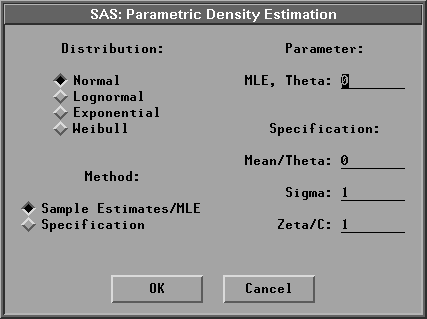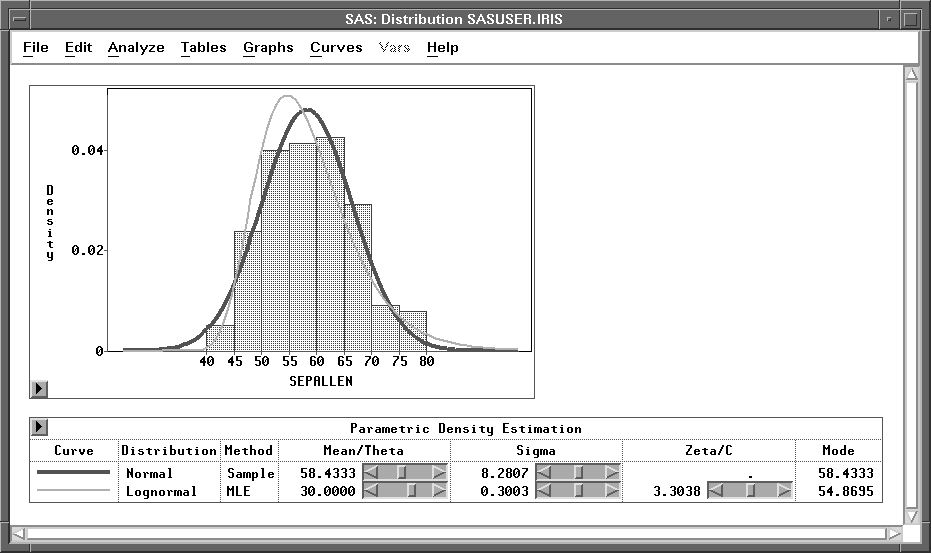| Distribution Analyses |
Parametric Density
Parametric density estimation assumes that the data are from a known family of distributions, such as the normal, lognormal, exponential, and Weibull. After choosing Curves:Parametric Density from the menu, you specify the family of distributions in the Parametric Density Estimation dialog, as shown in Figure 38.23.

Figure 38.23: Parametric Density Dialog
The default uses a normal distribution with the sample mean and standard deviation as estimates for ![]() and
and ![]() .You can also specify your own
.You can also specify your own ![]() and
and ![]() parameters for the normal distribution by choosing Method:Specification in the dialog.
parameters for the normal distribution by choosing Method:Specification in the dialog.
For the lognormal, exponential, and Weibull distributions, you can specify your own threshold parameter ![]() in the Parameter:MLE, Theta entry field and have the remaining parameters estimated by the maximum-likelihood estimates (MLE) by choosing Method:Sample Estimates/MLE. Otherwise, you can specify all the parameters in the Specification fields and choose Method:Specification in the dialog.
in the Parameter:MLE, Theta entry field and have the remaining parameters estimated by the maximum-likelihood estimates (MLE) by choosing Method:Sample Estimates/MLE. Otherwise, you can specify all the parameters in the Specification fields and choose Method:Specification in the dialog.
If you select a Weight variable, only normal density can be created. For Method:Sample Estimates/MLE, ![]() and sw are used to display the density with vardef=WDF/WGT;
and sw are used to display the density with vardef=WDF/WGT; ![]() and sa are used with vardef=DF/N. For Method:Specification, the values in the entry fields Mean/Theta and Sigma are used to display the density with vardef=WDF/WGT; the values of Mean/Theta and Sigma/
and sa are used with vardef=DF/N. For Method:Specification, the values in the entry fields Mean/Theta and Sigma are used to display the density with vardef=WDF/WGT; the values of Mean/Theta and Sigma/![]() are used with vardef=DF/N.
are used with vardef=DF/N.
Figure 38.24 displays a normal density estimate with ![]() (the sample mean) and
(the sample mean) and ![]() (the sample standard deviation). It also displays a lognormal density estimate with
(the sample standard deviation). It also displays a lognormal density estimate with ![]() and with
and with ![]() and
and ![]() estimated by the MLE.
estimated by the MLE.

Figure 38.24: Parametric Density Estimation
The Mode is the point with the largest estimated density. Use sliders in the table to change the density estimate. When MLE is used for the lognormal, exponential, and Weibull distributions, changing the value of ![]() in the Mean/Theta slider also causes the remaining parameters to be estimated by the MLE for the new
in the Mean/Theta slider also causes the remaining parameters to be estimated by the MLE for the new ![]() .
.
Copyright © 2007 by SAS Institute Inc., Cary, NC, USA. All rights reserved.